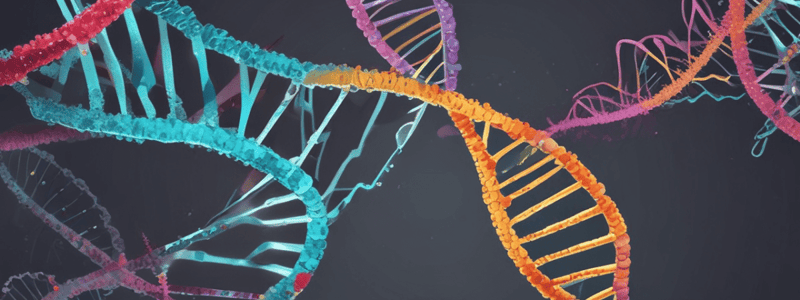Podcast
Questions and Answers
Which sugar is found in RNA?
Which sugar is found in RNA?
- Deoxyribose
- Fructose
- Glucose
- Ribose (correct)
Which nitrogenous base is a purine?
Which nitrogenous base is a purine?
- Adenine (correct)
- Uracil
- Thymine
- Cytosine
Which component is found in a nucleotide but not in a nucleoside?
Which component is found in a nucleotide but not in a nucleoside?
- Sugar
- Hydrogen bond
- Phosphate (correct)
- Nitrogenous base
What type of bond links the sugars and phosphates in a nucleic acid?
What type of bond links the sugars and phosphates in a nucleic acid?
According to Chargaff's rules, which pair bases are equal in amount?
According to Chargaff's rules, which pair bases are equal in amount?
Which nitrogenous base is found in RNA but not in DNA?
Which nitrogenous base is found in RNA but not in DNA?
What does it mean for DNA replication to be semi-conservative?
What does it mean for DNA replication to be semi-conservative?
What did the Hershey-Chase experiment conclude about genetic material?
What did the Hershey-Chase experiment conclude about genetic material?
Which base pairs with thymine (T) during DNA replication?
Which base pairs with thymine (T) during DNA replication?
What kind of bonds connect adenine (A) to thymine (T) in a DNA molecule?
What kind of bonds connect adenine (A) to thymine (T) in a DNA molecule?
What is the main requirement for the semi-conservative mechanism of DNA replication?
What is the main requirement for the semi-conservative mechanism of DNA replication?
Which form of DNA is most commonly found in solutions?
Which form of DNA is most commonly found in solutions?
Which process is illustrated by the creation of new DNA strands from existing ones?
Which process is illustrated by the creation of new DNA strands from existing ones?
How many hydrogen bonds connect cytosine (C) to guanine (G) in a DNA molecule?
How many hydrogen bonds connect cytosine (C) to guanine (G) in a DNA molecule?
Which base pairs with guanine (G) during DNA replication?
Which base pairs with guanine (G) during DNA replication?
Which of the following is not a component of DNA?
Which of the following is not a component of DNA?
Which of the following statements is true about the new DNA strands formed during replication?
Which of the following statements is true about the new DNA strands formed during replication?
What did the Meselson-Stahl experiment demonstrate about DNA replication?
What did the Meselson-Stahl experiment demonstrate about DNA replication?
Which form of DNA is characterized by a long, slender, left-handed helix?
Which form of DNA is characterized by a long, slender, left-handed helix?
Why are major and minor grooves formed in the DNA helix?
Why are major and minor grooves formed in the DNA helix?
Flashcards are hidden until you start studying
Study Notes
DNA Composition
- Deoxyribose is the sugar found in DNA, while Ribose is found in RNA.
Nitrogenous Bases
- Adenine, Guanine, Cytosine, and Thymine are the nitrogenous bases found in DNA.
- Uracil is found in RNA, replacing Thymine.
- Purines are nitrogen bases containing two rings, including Adenine and Guanine.
- Pyrimidines are nitrogen bases containing one ring, including Cytosine, Thymine, and Uracil.
Phosphate
- The phosphate group is represented by O-P-O- OH.
Nucleosides vs. Nucleotides
- A Nucleoside or Deoxynucleoside is a nitrogenous base bound to a sugar.
- A Nucleotide or Deoxynucleotide is a nitrogenous base bound to a sugar and a phosphate group.
- A Nucleic Acid is a polymer (chain) of nucleotides.
Facts
- Nucleic acids are polymers, and their monomers are called nucleotides.
- Nucleotides consist of a base, sugar, and phosphate group.
- Sugar can be deoxyribose or ribose.
- Phosphate groups link sugar molecules together through phosphodiester bonds.
Famous Experiments
Chargaff's Rules
- The amounts of Adenine (A) and Thymine (T) are equal, and the amounts of Guanine (G) and Cytosine (C) are equal.
- The amounts of A&T and G&C differ between species.
The Hershey-Chase Experiment
- The experiment showed that DNA, not protein, carries genetic information.
- Radioactive phosphorus, which labels DNA, was found in bacteria, while radioactive sulfur, which labels protein, was not.
DNA Composition - Double Helix
- The double helix structure of DNA consists of anti-parallel strands.
- Adenine (A) pairs with Thymine (T) through two hydrogen bonds.
- Cytosine (C) pairs with Guanine (G) through three hydrogen bonds.
- The major and minor grooves are formed due to the alignment of sugar-phosphate backbones.
DNA Conformations
- A-DNA is a short, wide, right-handed helix.
- B-DNA is the most common DNA form in solution, a right-handed helix.
- Z-DNA is a long, slender, left-handed helix.
The Meselson-Stahl Experiment
- The experiment showed that DNA replication is semi-conservative, not conservative or dispersive.
- Each new strand contains one original and one new strand.
DNA Replication
- DNA replication is semi-conservative and depends on complementary base pairing.
- Each new strand contains one original and one new strand, making it a semi-conservative process.
Studying That Suits You
Use AI to generate personalized quizzes and flashcards to suit your learning preferences.




